git clone https://github.com/[your github username]/portfolio.gitAssessments (APM)
List of All Assessments
The following assessments will be used to measure progress towards learning outcomes and to assign grades.
Notes
- Table of Learning Outcomes
| Learning Outcome | Supported BYU Aims |
|---|---|
| 1. Understand the basics of how LLMs generate natural language. | Intellectually Enlarging |
| 2. Develop and articulate a product strategy. | Intellectually Enlarging, Lifelong Learning and Service |
| 3. Analyze the physical, mental, and spiritual impact your product is likely to have on its users. | Spiritually Strengthening, Character Building, Lifelong Learning and Service |
| 4. Create a digital product that delivers value to a target customer group. | Intellectually Enlarging, Lifelong Learning and Service |
Knowledge Checks
Pre-Course Knowledge Check
The pre-course knowledge check is a 50 question multiple-choice exam. It does not count towards your grade but is required for you to complete. The purpose of the knowledge check is to understand your baseline level knowledge coming into the class.
Complete the exam on LearningSuite.
Do not use AI or any outside resources while completing the exam. Doing so would defeat its purpose and failed to give an accurate signal on base level knowledge.
The final exam will be very similar in content and structure and will be completed in the testing center.
Hence, comparing your final exam score to your score on the pre-course knowledge check will give you a good sense for what you have learned in the course.
Final Knowledge Check
The Final Knowledge Check will consist of a 50 question multiple choice test in the testing center.
Product Sprints
Sprint 1 – Deploy your fist app
Overview
The purpose of this homework assignment is to help you create a public facing portfolio containing your work that you can use to share with potential employers and others.
The deliverable for this homework is a single URL pointing to your personal portfolio published on the internet via GitHub Pages which will look like the following template
To actually submit the assignment, you need to complete the following steps:
- Publish your portfolio to the internet
- Once published, submit a single page PDF or Word Doc containing three things:
- A URL to your live product portfolio
- The name and relation of the person you showed your portfolio to (e.g. your roommate, parent, employer, etc)
- A few comments on how they reacted to what you showed them? i.e. what questions did they ask, what did they think overall?
Set-up
- Create a new repo from the following template on GitHub: https://github.com/byu-strategy/product-management-portfolio. Call the repo “portfolio”.
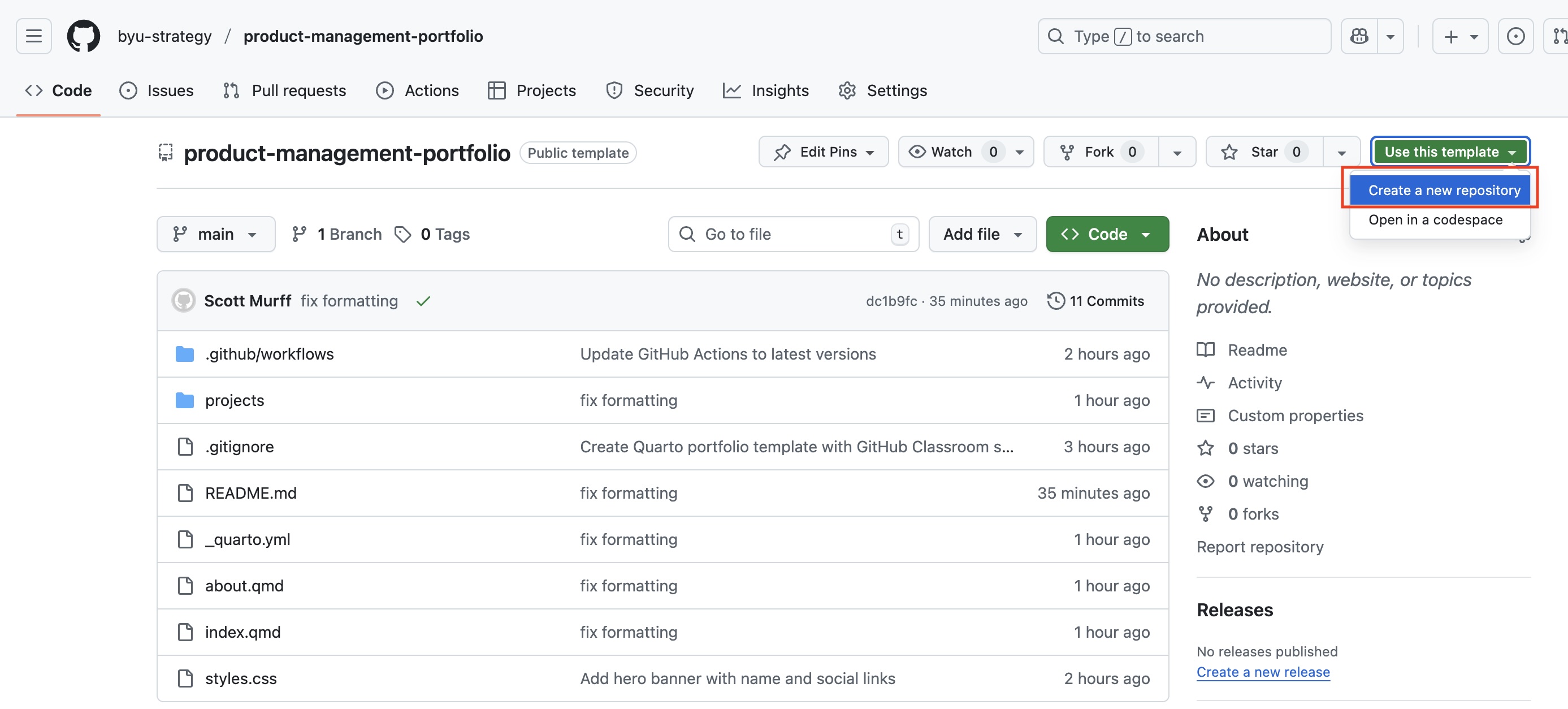
- After creating the repo, go to
Settings -> Pages -> Deploy from a branch, and selectGitHub Actions
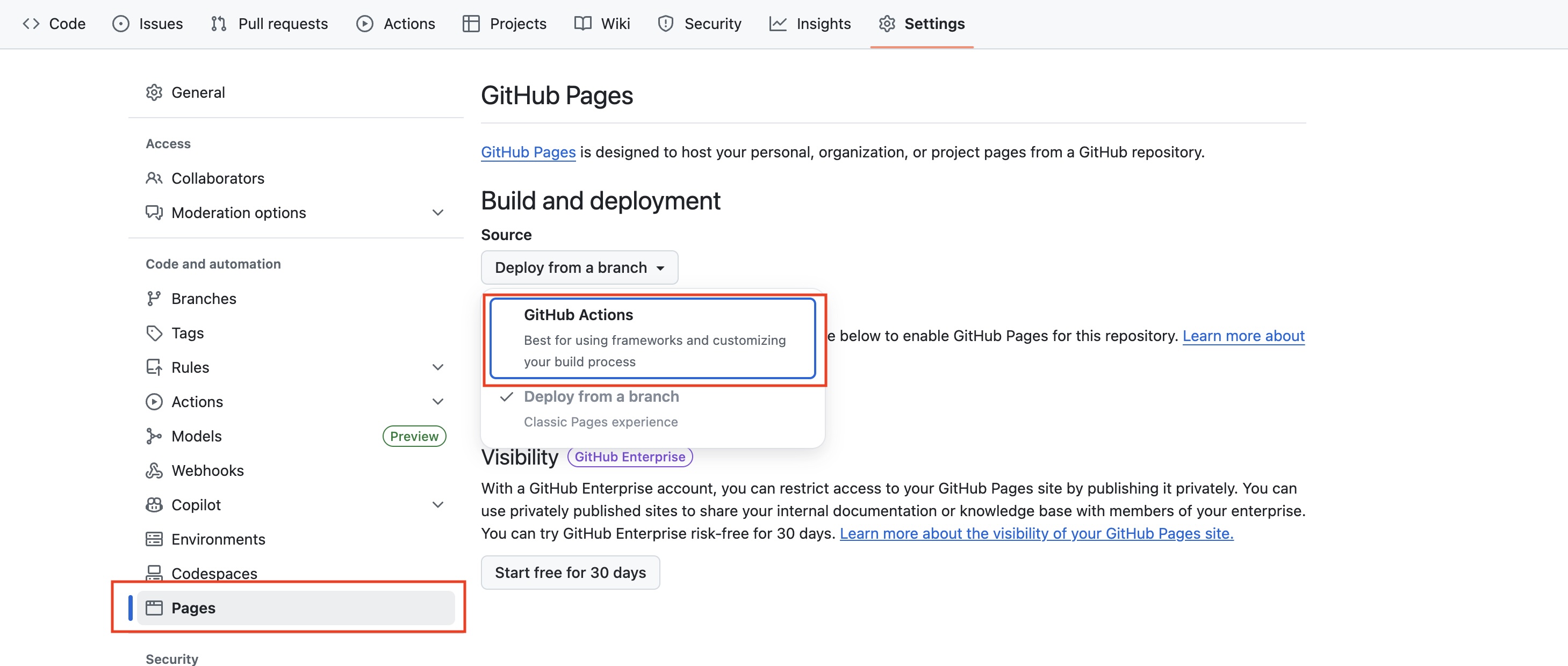 3) Start VS Code and then
3) Start VS Code and then Open -> Open Folder to the folder you want to save your portfolio files in. Then open a Terminal within VS Code.
- Copy/paste the URL of your new repo and run the following command from the terminal. Your URL should have the following structure: https://github.com/[your github username]/portfolio
Make sure to add .git to the end of the URL and update your user name before running the command.
- Then use the terminal to navigate into the newly cloned git repo (folder)
cd portfolioYou should now see all of the files from the repo in your left hand window pane within VS Code. These are the source files behind the template.
To complete the homework, you will edit and personalize the template. Once you are done editing, save all of the files and run the following git commands to publish your portfolio:
git add .
git commit -m "write a short message describing your changes"
git pushOnce you have pushed your changes, within about one minute, your website portfolio will be live at this URL: https://[your github username].github.io/portfolio/
Remember to update your user name in the URL.
You can preview what your portfolio looks like at any point by running this command from the terminal:
quarto previewFor this to work, you will need to install quarto. Get Claude code to help you install it.
Requirements
You should make at least the following changes to the source files of your portfolio.
- Add a personal photo (I recommend using your LinkedIn photo for a consistent online presence)
- Update and personalize the Home page (index.qmd)
- Update and personalize the About page (about.qmd)
- Update and personalize the project-1.qmd file to accurately reflect the application you built. Make sure to update the two buttons that contain links to your GitHub source code and your Vercel deployed app.
- Use AI or another tool of your choice to create a favicon and update the image reference in the
.yml. You could use an icon or just your initial(s). - Choose one other person to show your portfolio to and describe to them what you built. Take a couple minutes to explain to them the tools and skills you are learning.
Although not required for this assignment, you should feel free to make further enhancements and personalizations to your portfolio. You will continue to build on this portfolio throughout the course so it should be something you invest significant effort in as it can be a valuable tool for you in the future to showcase your skills.
Grading
This assignment is worth 40 points which equates to 8% of your grade.
A full score of 40 will be awarded if all requirements above are met and the portfolio is “client ready.” Client ready means you could show this to a real prospective employer with confidence, meaning there are no errors, all of the hyperlink’s work, etc.
One point will be docked for each aspect that is not “client ready.” For example, if a hyperlink doesn’t work, that’s -1 from the 40 possible.
Sprint 2 – Identify a problem worth solving
Overview
The purpose of this assignment is to help you identify and begin to validate a problem that you can solve with a digital product you will build in this class. A problem worth solving is one that creates meaningful value for people, organizations, or society. Value can take many forms such as saving time, reducing costs, improving health, or unlocking new opportunities.
A practical litmus test is whether someone is willing to pay money to see the problem solved, since willingness to pay is a strong signal that the problem is real, painful, and worth addressing.
At the conclusion of this assignment you will have a strong hypothesis on what problem you plan to work on solving for the remainder of the course.
The assignment consists of doing research to support your articulation of a problem with solving.
Requirements
Turn in a Word doc or PDF that includes the following:
In 1-3 sentences, write down a problem you believe in worth solving based on your research.
A summary of the evidence you have gathered that leads you to believe this is a problem worth solving? Sources of evidence could include the following:
- Your personal experience, preferences, and frustrations
- Exploratory interviews with other people
- Interviewing others while observing them complete where pain points may exist (contextual interview)
- Ethnographic observation of others (i.e. you’re not speaking with others you’re simply observing and taking notes)
- Networking and discussing with others
- Surveys
- Synthesis of information and data found online
- Running an experiment
- Networking with others you don’t normally talk with
You should think of your audience as a VC investor and you should be working to convince them that you’ve uncovered a real pain point that is worth investing in solving. It’s up to you to build that case for action by communicating whatever evidence you can bring to the table.
List each source of evidence and your synthesis of what it’s telling you.
Below are few frameworks you may find helpful to organize your thinking as you do your research. You are not required to use these frameworks. They are simply offered as optional resources that many people have found useful.
Importance vs Satisfaction Framework(click link to learn more)
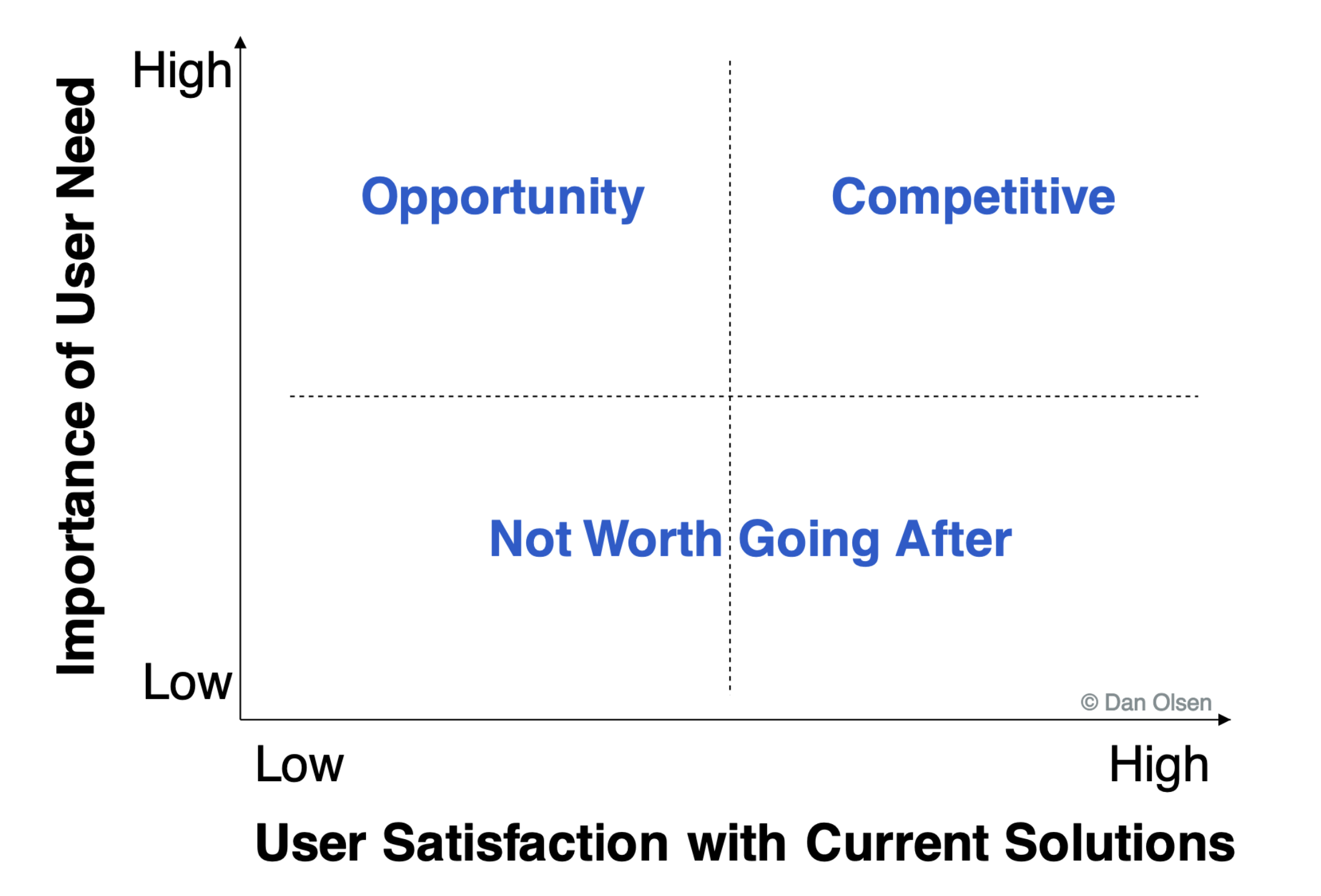
Jobs-to-be-Done(click link to learn more)
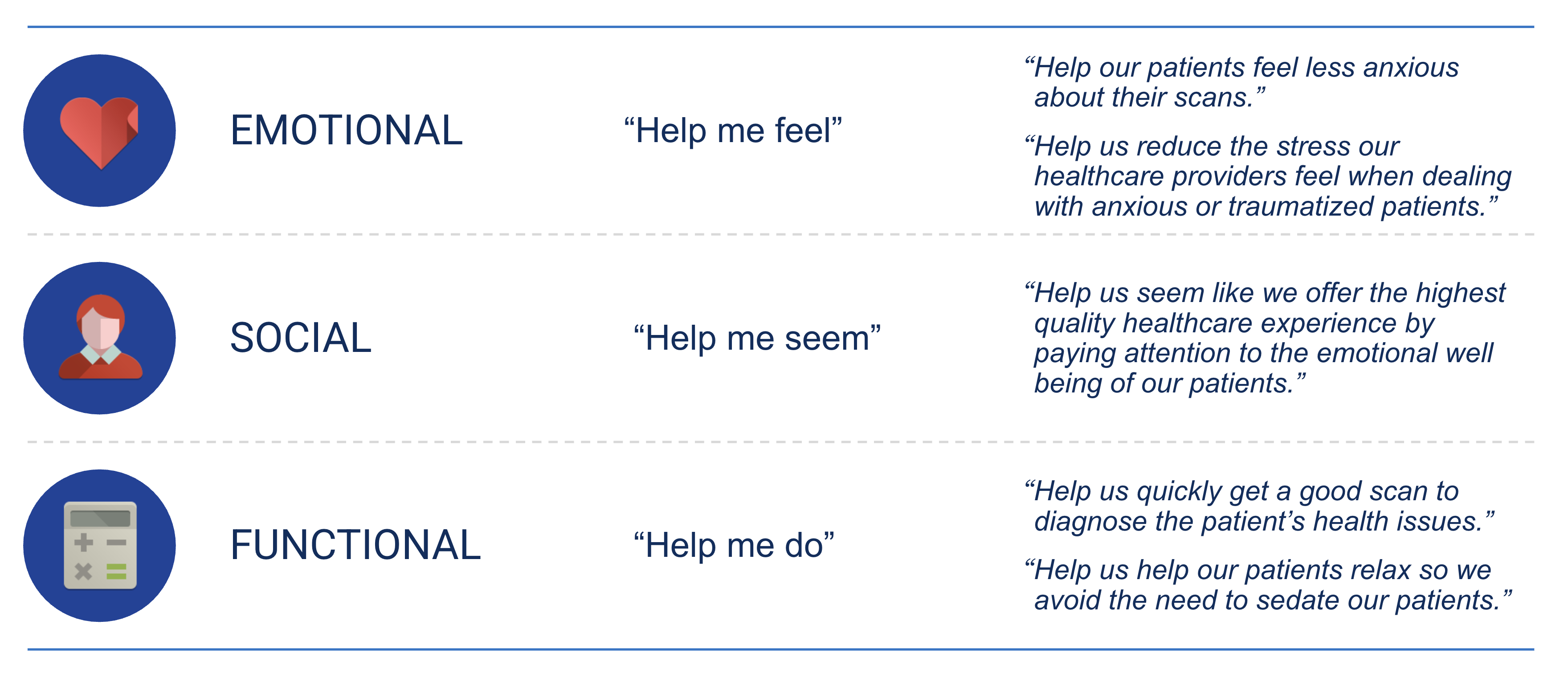
The Value Proposition Canvas(click link to learn more)
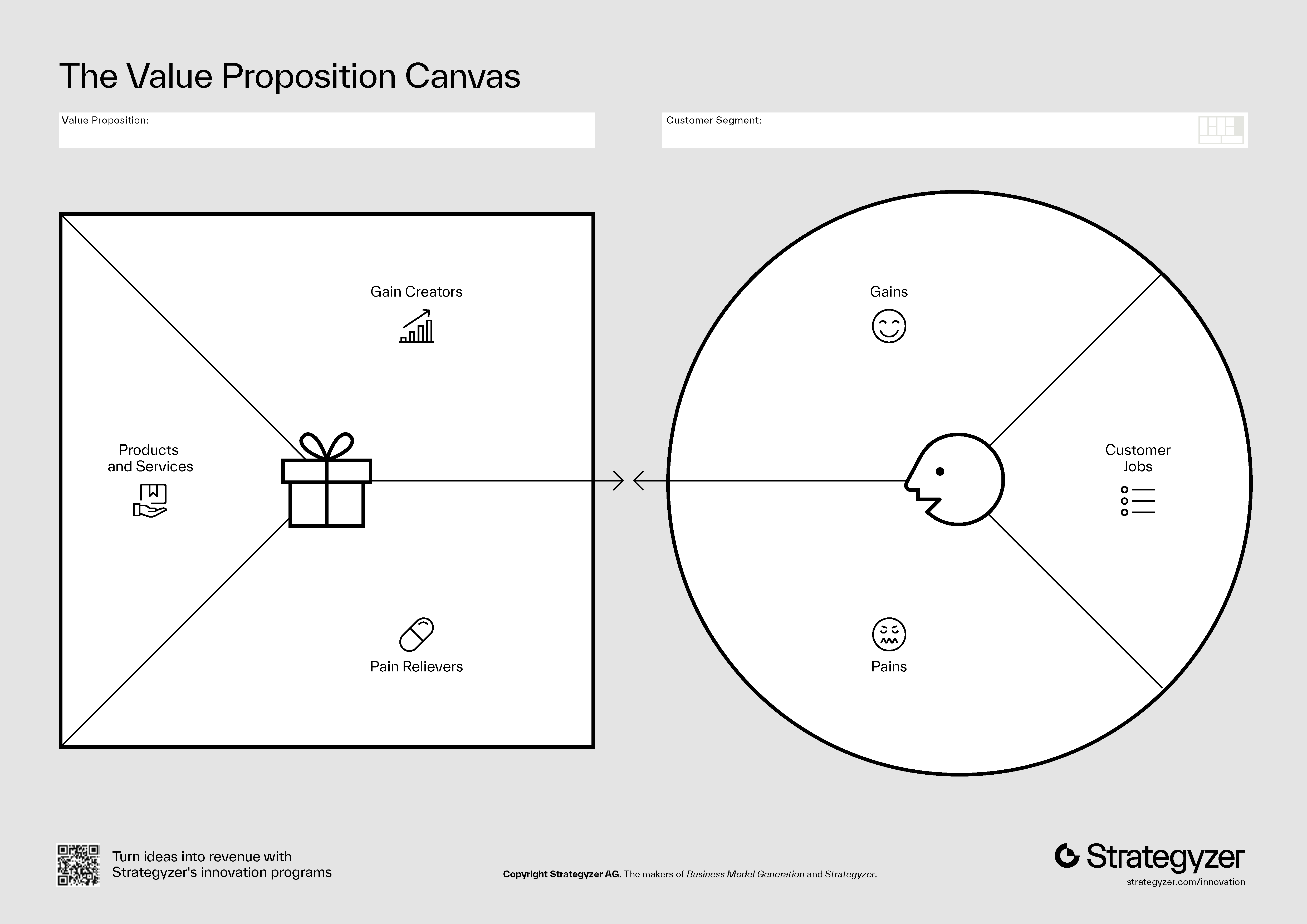
- Identify at least 1 persona of a customer that has the problem/job-to-be-done that you’ve identified. Document the following about this customer persona:
Name & Role (fictional but realistic)
- Give them a name and role to make the persona feel tangible (e.g., “Emily, 34, Busy Working Mom”).
Demographics
- Age, occupation, location, income level, education (only those relevant to the problem).
Goals / Motivations
- What do they want to achieve?
- Why does solving this problem matter to them?
Challenges / Pains
- What specific frustrations, risks, or obstacles do they face?
- How do these challenges affect their daily life or work?
Job-to-be-Done (JTBD)
- A statement capturing the core task or outcome they’re trying to achieve, usually framed like:
“When [situation], I want to [motivation], so I can [desired outcome].”
Current Solutions / Workarounds
- What are they doing now to solve or manage the problem?
- Why are these solutions insufficient?
Willingness to Pay
- How much would this persona realistically pay to make the problem go away?
Example Persona (Noise Disrupting Sleep Near Railroads)
Name & Role: Sarah, 42, Homeowner near rail line
Demographics: Married, 2 kids, suburban area, middle-class household income
Goals / Motivations: Wants her family to get consistent, restful sleep to improve health and productivity
Challenges / Pains: Train horns wake her children multiple times per night; she feels exhausted and less productive at work
Job-to-be-Done:
> “When loud train horns wake my family at night, I want a way to block or eliminate the noise so we can sleep peacefully and stay healthy.”
Current Solutions / Workarounds: Uses white noise machines and heavy curtains; they help a little but don’t stop the interruptions
Willingness to Pay: Would pay several thousand dollars for soundproofing or regulatory solutions, since the problem impacts family health and home value
Grading Rubric
- Problem Statement (5 points)
- 5 points: Problem is clearly articulated in 1–3 concise sentences, specific, and compelling.
- 3 points: Problem is stated but vague, overly broad, or not clearly framed.
- 1 point: Problem is unclear, incomplete, or missing.
- Evidence & Research (20 points)
- 16–20 points: Multiple sources of evidence are presented (e.g., interviews, surveys, observations, secondary data). Evidence is synthesized well and convincingly supports that the problem is real and meaningful.
- 11–15 points: At least two credible sources of evidence are presented with some synthesis, but the argument for the problem’s importance is only somewhat convincing.
- 6–10 points: Minimal evidence (one source) or evidence lacks depth; weak synthesis; limited support for the problem’s importance.
- 0–5 points: Evidence missing, irrelevant, or not tied to the problem statement.
- Customer Persona (10 points)
- 9–10 points: Persona is realistic, detailed, and includes all required elements (name/role, demographics, goals, challenges, JTBD, current solutions, willingness to pay). Clearly linked to the identified problem.
- 6–8 points: Persona includes most elements but lacks depth or specificity in some areas. Somewhat connected to the problem.
- 3–5 points: Persona is superficial, missing several required elements, or feels unrealistic. Weak connection to the problem.
- 0–2 points: Persona missing or incomplete.
- Clarity & Professionalism (5 points)
- 5 points: Submission is well-organized, professionally written, and free of errors. Audience (VC investor) is considered.
- 3 points: Submission is understandable but has some organizational, formatting, or writing issues. Limited consideration of audience.
- 1 point: Submission is unclear, poorly formatted, or contains frequent writing issues. Audience not considered.
This assignment is worth 40 points which equates to 8% of your grade.
Sprint 3 – First MVP with Database and Payments
Overview
The purpose of this homework assignment is to guide you through developing a full-stack MVP application with a front-end, back-end, database, and payment system.
Requirements
- One or more working features that deliver on your customer value proposition
- A functional back-end with Supabase, user authentication, and Stripe payments integrated
- Application deployed to Vercel
- I should be able to sign-up for an account on a free tier or trial and use your application.
- AI generated code review saved in a .md file using the following prompt to Claude Code:
“How many lines of code is my app? How well desinged is the app on a scale of 1-10? Would this stand up in a world class engineering shop? Save your response in a .md file”
Deliverables:
On LearningSuite, submit a single .md file containing Claude Code’s reponse to the prompt above. Add a link to your vercel hosted application at the very top of the file.
Grading Rubric
| Category | Description | Points |
|---|---|---|
| 1. Working Features | App has one or more working features that deliver clear value. | 0–10 |
| 2. Technical Setup | Supabase backend, user authentication, and Stripe payments are functional. | 0–10 |
| 3. Deployment | App is deployed on Vercel and can be used by the instructor (signup works). | 0–8 |
| 4. AI Code Review File | .md file includes Claude Code review and link to the app. |
0–8 |
| 5. Design & Usability | App looks clean and is easy to navigate. | 0–4 |
| Total: 40 Points |
This assignment is worth 40 points which equates to 8% of your grade.
Sprint 4: Code Base Teardown & Architecture Analysis
Learning Objectives
By completing this assignment, you will:
- Reverse engineer your own application to deeply understand its architecture
- Document how all components work together using visual diagrams
- Teach back your understanding through clear verbal explanation
Expected Time Required: 3-4 hours (2-3 hours analysis/documentation, 1 diagramming and video explanation)
Points: 40 points (8% of your grade)
Overview
You’ve built an MVP with a frontend, backend, database, and payment integration. Now it’s time to deepen your understanding of what you’ve created.
This assignment asks you to:
- Dissect your codebase using Claude Code.
- Create an annotated architecture diagram showing how everything connects
- Record a 2-3 minute video walking through your diagram and explaining your app’s architecture
Why This Matters: As a product manager working with engineers, you need to understand system architecture to make informed decisions about features, technical debt, scalability, and resource allocation. This assignment bridges the gap between “I built something with AI” and “I understand how systems work.”
Step 1: Code Base Analysis (AI-Assisted)
Use Claude Code to analyze your codebase. Run the following 4 prompts to save the responses as markdown files. Then read the newly created markdown files carefully, take the time to ask your preferred AI follow-up questions about things you don’t understand.
Prompt 1: Project Structure Analysis
Analyze my project structure and provide:
1. A complete list of all directories and their purposes
2. The role of each major file in the codebase
3. Which files are frontend, backend, configuration, or deployment-related
4. A count of total lines of code (excluding dependencies/node_modules)
Format this as a clear outline I can reference and save it as a new markdown file called code-base-analysis.md. Explain things simply to a brand new beginner who is on a fast track to becoming a world class engineer.Prompt 2: Data Flow Analysis
Trace the complete data flow in my application:
1. What happens when a user first loads the app? (step-by-step)
2. What happens when a user performs the main action in my app? (trace from UI click to database and back)
3. Where does user authentication happen?
4. Where does payment processing happen?
5. What data is stored in the database and why?
Show me the flow with specific file names and function names. Save this as a new markdown file called data-flow-analysis.md. Explain things simply to a brand new beginner who is on a fast track to becoming a world class engineer.Prompt 3: Architecture Pattern Identification
Analyze my application architecture and identify:
1. What architectural pattern am I using? (e.g., MVC, client-server, serverless, monolith)
2. How is my code organized? (e.g., by feature, by layer, mixed)
3. What are the main components/modules and how do they interact?
4. Which parts of my code handle which responsibilities? (UI, business logic, data access, authentication, payments)
5. Are there any architectural anti-patterns or code smells I should be aware of?
Explain in terms I can understand as a product manager learning technical concepts. Save this as a new markdown file called architecture-pattern.mdPrompt 4: Dependency Mapping
Create a comprehensive list of:
1. All external services my app depends on (Vercel, Supabase, Stripe, etc.)
2. All major libraries/packages and what they do
3. All API endpoints in my backend (list each route and its purpose)
4. All database tables and their relationships
5. Any third-party integrations
For each dependency, explain WHY it's needed and what would break if it failed. Save this as a new markdown file called dependency-mapping.mdStep 2: Create an Architecture Diagram of your App
Now use what you’ve learned from the AI responses to create a visual architecture diagram. You have two options:
Option A: AI-Generated Diagram
Run the following prompt in Claude Code
Based on our analysis, create a visual architecture diagram for my application using Mermaid syntax.
The diagram should show:
1. Frontend components (user interface, forms, displays)
2. Backend API routes and their purposes
3. Database tables and what data they store
4. External services (Vercel, Supabase, Stripe, etc.)
5. Data flow arrows showing requests and responses
6. Authentication flow
7. Payment flow
Use the engineering landscape diagram style with clear sections for:
- Application Architecture (Frontend/Backend)
- Languages & Frameworks used
- External Services
- Database Schema
- Request/Response flows
Make it detailed enough to explain to a technical interviewer.The AI will generate Mermaid code. Then ask:
Convert this Mermaid diagram to a visual format I can export as a PNG or PDF.
OR
Show me how to render this Mermaid code as an image using an online tool.Option B: Manual Diagram Creation
If you prefer to create the diagram manually, use any of the following tools or another one you prefer:
- Mermaid Live Editor - paste Mermaid code, export as PNG
- Excalidraw - hand-drawn style diagrams
- draw.io - professional diagrams
- PowerPoint/Google Slides - if you prefer manual creation
Tips for Visual Style: - Use arrows to show direction of data flow - Include labels and short descriptions where needed for clarity - Make it visually clear and uncluttered
Step 3: Video Walkthrough and Explanation
Create a 2-3 minute video recording with screen share where you walk through your architecture diagram and explain your application’s architecture.
Recording Tools (choose one):
- Loom (recommended) - Free, easy, browser-based recording
- Zoom - Record yourself with screen share
- QuickTime (Mac) - Built-in screen recording
What to Cover in Your Video
Your video should address the following (think of it as teaching this to a classmate who hasn’t seen your app):
Introduction (15-20 seconds)
- Brief description of what your app does
Architecture Overview (30-40 seconds)
- Screen share your diagram and explain the main sections
Data Flow Walkthrough (60-80 seconds) Pick ONE main user action and trace it through the entire system:
Example: “Let me explain what happens when a user signs up and makes their first purchase…”
- User Action: “User clicks ‘Sign Up’ on the frontend”
- Frontend → Backend: “The form sends a POST request to my
/api/signupendpoint” - Authentication: “The backend uses Supabase Auth to create the user account”
- Database: “User data is stored in the
userstable with their email and password” - Payment Flow: “When they click ‘Subscribe’, we redirect to Stripe Checkout”
- Backend → Database: “The backend updates the
subscriptionstable with their payment status” - Response → Frontend: “The user is redirected back to the app and sees their dashboard”
Key Insights (20-30 seconds)
- Mention one thing you learned from doing this analysis
- Mention one architectural decision you discovered about your app and why it matters
- Optional: Mention one thing you’d improve if you rebuilt this
Submission
Submit via LearningSuite:
- Video Link - A file containing your video or a link to it
- Analysis Files - All 4 markdown files:
code-base-analysis.md,data-flow-analysis.md,architecture-pattern.md,dependency-mapping.md
Note: Your architecture diagram should be shown in your video, so no separate diagram file is needed.
Grading Rubric (40 Points Total)
| Category | Description | Points |
|---|---|---|
| Analysis Files | All 4 markdown files submitted with comprehensive analysis showing deep investigation of codebase | 0-20 |
| Technical Understanding in Video | Demonstrates clear understanding of architecture and accurately traces data flow through system | 0-10 |
| Diagram Quality (shown in video) | Diagram is visible, comprehensive, and clearly shows frontend, backend, database, services, and data flows | 0-10 |
| Total: 40 |
This assignment assesses:
- Learning Outcome 4: Create a digital product that delivers value to a target customer group
- By demonstrating deep understanding of your own product’s technical architecture
- By documenting system design decisions
- By communicating technical concepts clearly
Remember: The goal of this assignment is not to prove your app is perfectly architected. The goal is to demonstrate that you understand how software systems work by analyzing, documenting, and explaining the system you’ve built.
This is a critical skill for product managers who need to have technical conversations with engineering teams, make informed decisions about features and timelines, and understand the implications of architectural choices.
Engagement Checks
Engagement Checks provide a brief opportunity at the end of class for you to demonstrate your understanding of key concepts discussed that day and to reinforce active participation in the learning process.
Engagement Checks occur during the final ten minutes of class. They consist of writing your answers to five questions, the topics of which were discussed during class that day.
The questions are presented on a slide and students are provided a note card to write their answers. Each student should bring their own pen or pencil. Students should include their name and the day their section (i.e. Monday) meets in order to get credit.
A list of the Engagement Check dates and associated readings are shown on the course schedule.
Research shows that writing down what you’ve just learned helps your brain remember it better. Psychologists call this the “testing effect” or “retrieval practice”: when you pull ideas out of your head and put them into words, you strengthen your memory far more than by just rereading or listening. Writing answers to a few questions at the end of class also helps you notice what you do and don’t understand, making your study time more effective later. These quick Engagement Checks aren’t busywork, they’re a proven way to lock in the key ideas from class so you actually remember them.
Final Product Demo
Purpose:
The purpose of this assessment is for you to demo the culmination of all of your work on your product this semester.
To complete the assessment, record a 5-10 minute video (Zoom, Loom, phone camera, etc.) that includes the following three parts:
- Context (30-60 seconds)
- Remind us what your venture/product is.
- End-to-end Product Demo (2-4 minutes)
- Via screenshare or other video
- Illustrate the end to end user journey(s) that a user of your product can go through. i.e. click through and explain your product features, showing how a user will use it. If there are any feature that don’t work as intended, commment on these.
- Open up Supabase (or other database if not Supabase) and show and explain your database schema. Open up a specific table and show and comment on what data you see in the table. Where on the UI does that data originate from?
- Reflections (2-4 minutes)
- How has your overall experience in this class? What’s been good, what’s been not so good?
- On a scale of 1-10 how happy and satisfied are you with the product that you have built this semester?
- What are the two or three most valuable things you have learned this semester while building your product?
- How can I improve this course so that future students have an even better learning experience?
This final demo/video is worth 150 points which equates to 30% of your grade.
We will evaluate this final demo on the following criteria:
- Clarity of value prop: Can I quickly understand what you’re product is and the customer value you are seeking to provide? (10 points)
- Evidence of production ready product during demo: Does your product work and illustrate real thought and effort in delivering value to your intended target user? (100 points)
- Reflections: Do you address all 4 of the reflection questions? (40 points)
Feedback Surveys
Mid-Semester Feedback Survey
If you complete this survey, we will take your lowest Engagement Check score and convert it to a perfect score.
Student Ratings
If you complete this survey, we will take your lowest Engagement Check score and convert it to a perfect score.
